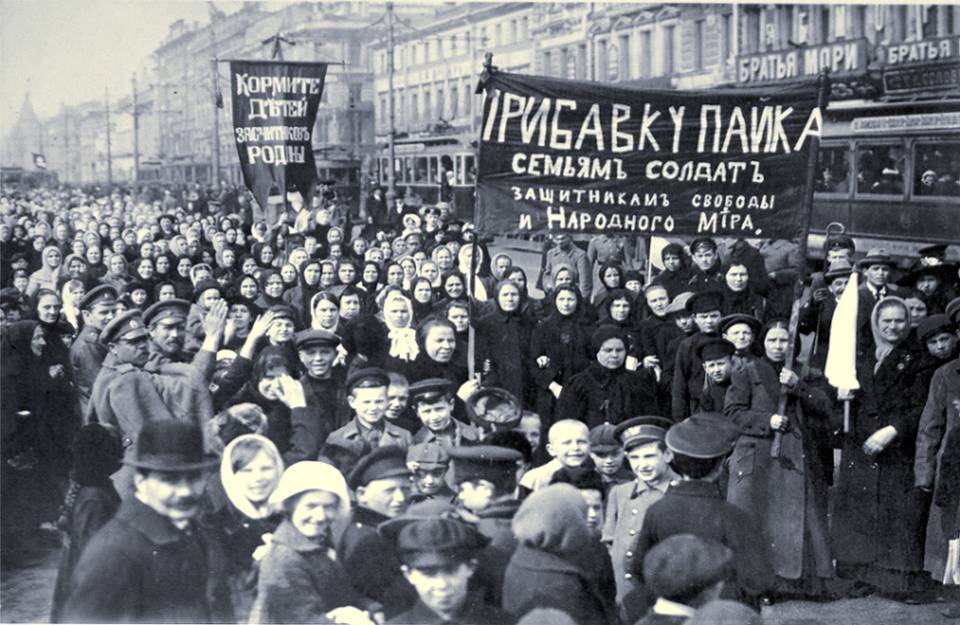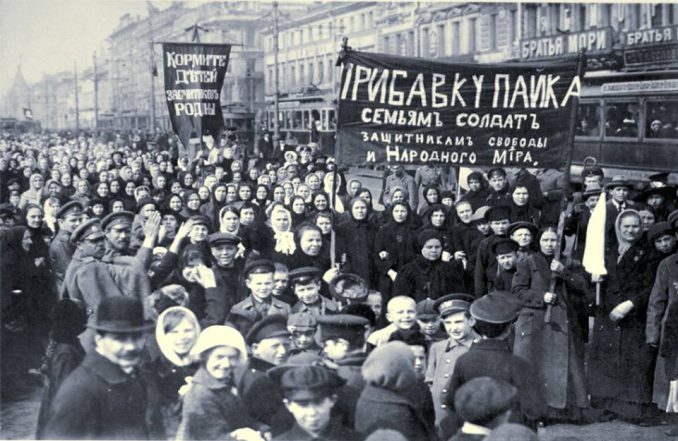



On Feb. 23, 1917, by the Julian calendar used in Russia at that time — March 8 in the rest of Europe — a 25-year-old revolutionary sailor, whose Bolshevik party name was Raskolnikov, looked out his window in Petrograd, Russia’s industrial center and capital.
The Russian rulers had decided calling the city Petrograd instead of Saint Petersburg would sound less German, as they were at war with Germany. Raskolnikov thought, “Today is Women’s Day. Will something happen in the streets today?” Something did happen. Some 128,000 workers were on strike. The whole city was seething.
As things turned out, “Women’s Day” was fated to be the first day of the revolution. Working women, driven to despair by their hard conditions and prey to the torments of hunger, were the first to come out onto the streets demanding “bread, freedom and peace.” The crowds were facing down police mounted on horses, who would push the people around or smack them with the flat side of their swords.
Wrote one observer: “[A]s soon as the mounted policemen had returned to the roadway, the crowd would close up again into a solid mass. In some of the groups we could see men, but the overwhelming majority consisted of working women and workers’ wives.”
Eight weeks earlier, as 1917 was beginning, Vladimir Ilyich Ulyanov, whose party name was Lenin, was in exile in Zürich, Switzerland, where he had been organizing and speaking against the great imperialist war. In a talk to young students, he remarked that Russians as old as he was — forty-six at the time — would likely never see a revolution overthrow the Russian czar, but that the youth would.
Even this most revolutionary leader of the working class was surprised by the explosive speed of change in Russia. One can only imagine how oblivious Czar Nicholas II was at that time to his imminent fate.
As Raskolnikov wrote, the first of the two 1917 revolutions in Russia began on Feb. 23 with a strike of women workers on International Women’s Day. The action grew into a general strike and mass political revolution in the capital city that overthrew the czarist monarchy that had ruled Russia since 1547. The attitude and actions of low-ranking soldiers and sailors were a determining factor in the revolution’s success.
Background to the revolution
The czarist empire had ruled over many subject peoples — Finns, Lithuanians and Estonians in the Northwest; Poles and Ukrainians in the West; Georgians, Armenians and many Turkic and mostly Muslim peoples in the Caucasus and South; plus Indigenous peoples throughout the Arctic and Siberian regions; and Jews and other minorities throughout its vast territory.
Czarist Russia was far less developed economically than the major imperialist powers in Western Europe — Germany, France and Britain. Some five-sixths of Russia’s 185 million people were peasants, who had been liberated from legal serfdom in 1861, but were still in the thrall of the landlords and the nobility. About twenty-six million of its people were wage laborers in 1917, including 6.5 million farm laborers and another six million in private and state-owned industry.
Although a smaller part of the total population than in Germany, Britain and the United States, the workers in Russian industry were more concentrated, toiling in recently established giant factories that employed thousands and even tens of thousands of workers.
Russia was by far the poorest of the major countries, yet some fifteen million men, mainly peasants, were drafted and thrown into the battles of World War I, with little training or equipment. They were cannon fodder. By 1917, more than two million had died and another four million were wounded.
With so many men under arms, a large number of women were employed in heavy industry in Petrograd; women made up about one-third of the workforce there. More than 100,000 of these women went out on strike on Feb. 23, defying the czarist state, defying the cautions of their political parties, defying everyone. That first day, the striking women escaped clashes with the police generally unscathed.
Encouraged by this success, male workers joined the women the following day, and in all more than 200,000, or half of the city’s workers, were in the streets. General Sergei Khabalov, who commanded the Petrograd army garrison, was responsible for controlling the demonstration.
But the workers, and especially the women, many of whom were soldiers’ wives, were talking with the garrison troops. They were even approaching the Cossacks, who were mounted troops often used in punitive actions against crowds, but who showed the workers they were weary of this unpleasant duty. On the other hand, the workers were hostile toward both the regular police and the secret police; the latter especially were enemies of the people and staunch defenders of the czar.
A political intellectual named N.N. Sukhanov, who was in the internationalist wing of the Menshevik Party (the right wing of the old Russian Social Democratic Labor Party), wrote a detailed eyewitness account of the 1917 Revolution. In this book, he described one telling moment when a Cossack became so riled up seeing a police inspector attack one of the demonstrators with his sword that he “flew at the inspector and slashed off his hand.”
Soldiers turn the guns around
On Feb. 26, as ever-friendlier fraternization between the workers and the troops was going on, something special happened. Something like this has probably taken place in every successful revolution in urban society. Soldiers from the Pavlovsky regiment, a major military unit of the Petrograd Garrison, witnessed a police unit on one side of a river fire on the people protesting on the other. Sukhanov wrote:
“Seeing this shooting at unarmed people and the wounded falling around them, and finding themselves in the zone of fire, the Pavlovskys opened fire at the police across the canal.”
When a regiment as big as the Pavlovsky breaks with tyranny, its soldiers have only one road forward: Spread the rebellion — or die. That same day representatives of the workers and peasants’ parties — the Mensheviks, the Bolsheviks and the Social Revolutionaries — gathered to form the Petrograd Soviet, the Russian word for “council.” This political leadership of the revolution, for its part, had to help spread the soldiers’ rebellion.
That evening, the Provisional Executive Committee, elected from the Petrograd Soviet, convened, declaring that the Soviet was now open. Its first task was to begin organizing emergency rations for the garrison troops who had come over to the revolution. The mutinous soldiers knew they were still a minority of the garrison, and their lives were on the line if the revolution were not carried through to the end. They needed to act.
They began to arrest members of the ordinary police, still loyal to the czar, and of the hated secret police. One by one the troops of a dozen other regiments met and decided to pledge their allegiance to the Petrograd Soviet of Workers’ Deputies. Their representatives went to the Petrograd Soviet and reported from the regiments’ assemblies:
“They told us to say that we refuse to serve against the people any more, we’re going to join with our brother workers, all united, to defend the people’s cause. … We would lay down our lives for that. Long live the revolution!”
Soviet reaches out to the troops
At this point the political leaders changed the name of the Soviet of Workers’ Deputies to the Soviet of Workers’ and Soldiers’ Deputies, thus fusing the spontaneous rank-and-file soldier organizations to the workers’ councils.
The Soviet received a report that a regiment loyal to the czarist regime was arriving, which caused some nervousness, but Sukhanov ended his text with this description that showed how much the population and all of the army had turned against Czar Nicholas and the war:
“Later we [Soviet members] became persuaded that any attempt to dispatch troops for the pacification of Petersburg was fruitless. All the ‘loyal’ troops preserved their loyalty and obeyed their commanders only as far as the railway stations, then immediately went over to the side of the revolution, and the commanders obeyed them.”
The Bolsheviks, Lenin’s party, may have been as surprised as everyone else with how quickly the revolutionary movement was developing, but they were the first to adapt to the new situation. Groups of Bolshevik workers raided police stations, took weapons and passed them out to their supporters. The soldiers, who as a whole were still wavering, could then see there were armed, determined and well-organized contingents of workers who were ready to see the revolution to its end.
With tens of thousands of troops already in a state of mutiny and facing deadly punishment if the revolt were to end before overthrowing the czar, the troops who had already mutinied had no option but to reach out to their brother soldiers and win them over to the revolution. It was no difficult task, as the rank-and-file soldiers were completely fed up with the hated czar and the rest of the nobility, and most were anxious to return to their farms. In the next few days the entire Petrograd garrison joined the Revolution.
The empire ends
Pressured by the bourgeois parties in a new government, on March 1 Czar Nicholas II attempted to abdicate in favor of his brother Mikhail, but Mikhail refused to take over the sinking ship. The czarist ministers were arrested.
Armed soldiers answering to the Soviet arrested any police who were still on the streets interfering with the masses, who were in turn tearing down the symbols of czarist rule. On March 3, the Executive Committee of the Petrograd Soviet ordered the arrest of the czar, who attempted to flee. He was captured, along with the rest of the royal family. The empire had ended.
It was the first big step that was to lead over the next eight months to a revolution that would not only remove the nobility but end the rule of the capitalists and change the course of the 20th century.
Sources: Raskolʹnikov’s “Kronstadt and Petrograd in 1917”; Sukhanov’s “The Russian Revolution 1917,” Vol. 1; and “1914-1918-Online. International Encyclopedia of the First World War (WW1).”
Hamas issued the following statement on April 24, 2025, published on Resistance News Network. The…
By D. Musa Springer This statement is from Hood Communist editor and organizer D. Musa…
Portland, Oregon On April 12 — following protests in Seattle and elsewhere in support of…
This statement was recently issued by over 30 groups. On Friday, March 28, Dr. Helyeh…
When Donald Trump announced massive tariffs on foreign imports April 2, Wall Street investors saw…
The century-long struggle to abolish the death penalty in the U.S. has been making significant…